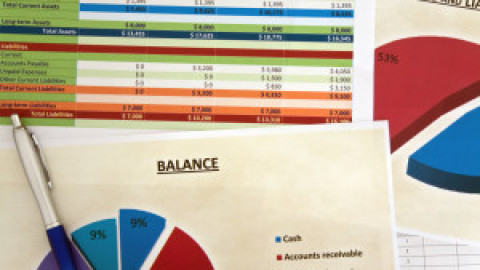The financial statements your chartered accountant or virtual CFO prepares for you should illustrate how well your business is performing.
Information can be drawn from three key financial statements.
Your profit and loss statement, shows the amount of profit or loss you have generated during a period. Secondly, your balance sheet is a snapshot, at any given date, of your business’ assets (what you own), liabilities (what you owe) and equity. It illustrates whether your business is solvent and able to repay its debts.
The third, the cash flow statement, shows how much cash your business has generated and how you have used the funds. Successful entrepreneurs know how to read and interpret these statements. This article shares a few of the common financial ratios that are used.
Definition
First, a definition for a financial ratio seems appropriate. Using two numbers extracted from your financial statements a financial ratio simply expresses them in relation to each other.
The following ratios will be helpful for most types of business, regardless of business sector or size. However, they’d be more meaningful if you compare ratios from one period to the next or to those seen in your own business sector.
Solvency Ratios
Solvency ratios are used to calculate a business’ ability to repay its debts as they fall due. The two most popular ones used are:
- Current Ratio, which is a key indicator of your ability to pay your bills as they fall due. It’s measured by dividing your current assets by your current liabilities. Both figures will be found on your balance sheet.
- Quick Ratio (also known as the Acid Test) shows your ability to pay debts on time without selling existing stock. It’s calculated by dividing your current assets (less stock) by your liabilities.
Banks favour these ratios when lending funds. Generally higher ratios illustrate higher ability to pay debts on time.
Profitability Ratios
Profitability ratios are used to determine a business’ financial performance (also known as profitability). They are expressed by showing profit as a percentage of another figure. The most common ones are:
- Gross Profit Margin, shows the amount of profit you’ve generated before deducting your overheads and other expenses. It’s calculated by dividing your gross profit by your sales and shown as a percentage. For example: if your sales were $80,000 and the cost of your purchases and materials were $24,000, your gross profit margin is 30.0%.
- Net Profit Margin, or net profit divided by sales, measures how much profit you have made as a percentage of your sales. For example: if your net profit was $5,600 and your sales were $80,000, your net profit margin is 7.0% – your business makes $7 for every $100 of sales.
- Return on Assets (ROA), or net profit divided by your total assets (which you’ll find on your balance sheet). It shows how well you are utilising your assets to generate income.
- Return on Capital Employed (ROCE), shown as your net profit divided by the business’ equity. It illustrates how much profit you have generated as a percentage of how much you have invested in your business.
- Earnings before interest and tax margin (EBIT) is simply the profit you make, excluding interest on lending and taxation divided by your sales. It’s a useful ratio to determine how profitable your operating activities have been. Banks tend to pay close attention to this ratio.
Use these ratios to compare your business with similar businesses in your industry. They’re also useful to identify trends and to compare your business’ performance from one period to the next. If your profitability ratios are deteriorating, they’re usually a good indicator that you need to take corrective action.
Efficiency Ratios
Efficiency Ratios illustrate if you’ve managed your assets and liabilities effectively. Common ones include:
- Asset Turnover, shown as your sales divided by your assets. Higher numbers will generally indicate that you’ve used your assets well to generate your sales.
- Days Sales Outstanding (DSO) is calculated by dividing your debtors figure (taken from your balance sheet) by your annual revenue and then dividing that figure by 365. It illustrates how long it takes you to collect what you’re owed (on average). For example; if your credit sales were $80,000 for the year and your debtors were $9,000, your DSO is 41 days – or it takes you 41 days to be paid, on average.
- Days Payables Outstanding (DPO), shows the ratio of your creditors to your average of cost of sales. The formula is trade creditors divided by your cost of sales and further divided by 365. For example, your cost of sales were $24,000 and your balance sheet shows that you owed $1,500 for materials. Your DPO is 23 days, or you take 23 days to pay your suppliers.
- Inventory Days, shows how long it will take you to sell all of your stock (on average). It’s calculated by dividing your average stock by your cost of goods sold and then multiplying that figure by 365. Let’s say that your inventory was $2,500, on average, and your cost of sales was $24,000, your Inventory Days would be 38 days. In other words, it would take you 38 days to sell of your current stock.
As with the profitability ratios, you’d find it useful to compare changes in these ratios from one period to the next.
Leverage Ratios
Leverage ratios measure how much debt you rely on to operate or fund your business. Two key ones include:
- Interest Cover, measures your ability to meet your interest payments on time. For example: Your EBIT is $6,800 and your interest for the year was $1,200. Your interest cover is 5.7 times, which means you can afford to pay the interest on your current debt.
- Debt to Equity, shows how much you have borrowed compared to how much you have invested. It’s calculated by dividing your total liabilities by your business’ equity. Generally, a high debt to equity ratio may be cause for concern.
Most business owners borrow at some point. Similar to a loan for a house, a business can use debt to funds investments which it may otherwise struggle to find. Debt generally only becomes an issue when repayments are so high that they cannot be supported.
As discussed, these ratios are more meaningful if you compare them to your previous accounting periods or with businesses in the same industry as you’re in. Most virtual CFOs are highly trained to use and interpret them for you.















